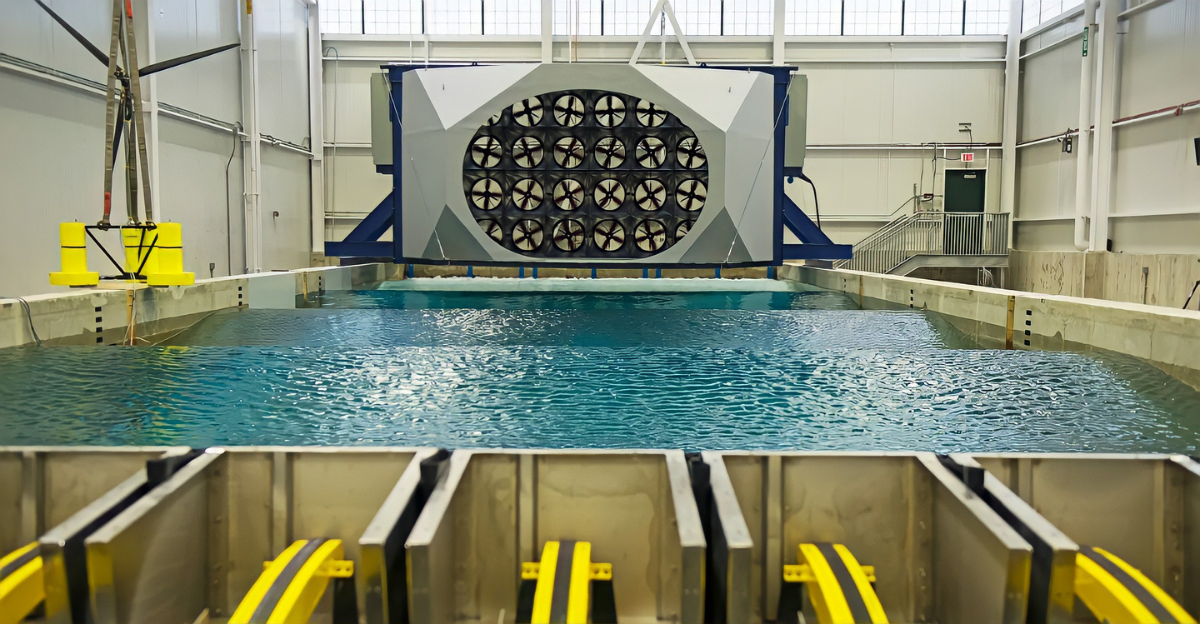
The Simulator for the Ocean “Microscope” China’s LICOMK++ ocean simulator, which achieves an unprecedented spatial resolution of 1 kilometer (0.6 miles) in global ocean modeling, is a quantum leap in climate science. Known as the first ocean “microscope,” it enables scientists to view oceanic processes, such as eddies, currents, and heat transport, with previously unachievable microscopic precision.
The increased accuracy of the simulator promises revolutionary advancements in predicting extreme weather events like floods, typhoons, and marine heatwaves, providing vital resources for disaster preparedness and climate adaptation globally. Beyond the direct scientific advantages, LICOMK++ represents a more significant change in how people approach climate and oceanic issues. Despite making up more than 70% of the Earth’s surface, the ocean is crucial in controlling global climate systems, but because of technological constraints, its intricate dynamics have remained elusive.
From Rough Models to Accurate High-Resolution Images

Computational power has historically been a constraint on ocean modeling, with coarse resolutions masking fine-scale dynamics crucial to understanding the climate. Ocean eddies, which control the movement of heat and carbon, are examples of mesoscale and sub-mesoscale phenomena that were not adequately captured by earlier models, which had a resolution of tens of kilometers.
Although valuable, observational data from ships, buoys, and satellites has historically been a significant part of oceanographic research. However, this data only covers a limited amount of space and time. This gap was filled by numerical models, but they were limited by the computing power and data assimilation methods that were available.
Strategic Reasons — Sanctioned Technological Sovereignty

LICOMK++ is a direct reaction to export restrictions on semiconductors spearheaded by the United States that are intended to restrict China’s access to cutting-edge computing technology. China demonstrates its technological dominance in a crucial scientific field by developing innovative solutions to circumvent these sanctions using in-house hardware and proprietary algorithms.
Beyond climate science, the ramifications show rivals around the world that China can create innovative technologies in spite of outside influences. By forcing nations to reevaluate supply chains and collaboration frameworks in crucial research areas, this approach may hasten the decoupling of technological ecosystems and ultimately change the global order in science and technology.
Impacts on Science and the Environment: Transforming Climate Forecasting

Over 90% of the excess heat from global warming and more than 30% of anthropogenic CO2 emissions are absorbed by the ocean, making it Earth’s central heat and carbon sink. For accurate climate projections, ocean dynamics must be accurately simulated. Forecasts of extreme weather events such as typhoons, floods, and marine heatwaves are greatly enhanced by LICOMK++’s high-resolution modeling, which captures the fine-scale processes that drive heat transport and ocean-atmosphere interactions. Globally, this accuracy improves coastal resilience planning, disaster response, and early warning systems.
These insights are essential for policymakers looking to put into practice efficient mitigation and adaptation strategies. LICOMK++ can also assist marine ecosystem management by offering granular data, which can help anticipate and lessen the effects of warming oceans on fisheries and biodiversity. Its contributions reinforce the link between environmental health and human well-being and go beyond climate science into socioeconomic fields.
Innovation in Technology — Breaking Through Computational Obstacles

The enormous computational resources required to achieve 1 km resolution globally have historically been a bottleneck in climate science. By using customized algorithms and optimized programming that optimize performance on domestically manufactured supercomputers, LICOMK++ overcomes this obstacle through creative software engineering. In addition to getting around hardware embargoes, this method raises the bar for algorithmic complexity. By incorporating real-time satellite data, the system improves model accuracy and produces a dynamic, adaptable simulation environment.
The success of the project shows how developed China’s domestic software ecosystem and high-performance computing infrastructure are and how they can compete with or even outperform their Western counterparts in specific applications. This invention also emphasizes how crucial it is for oceanographers, computer scientists, and engineers to work together across disciplinary boundaries. LICOMK++ establishes a standard for upcoming climate models as computing power increases, possibly spurring comparable developments globally and quickening the rate of discovery in Earth system sciences.
Geopolitical Aspects: Science as a Tool for Soft Power

China’s ocean simulator is a geopolitical statement as well as a scientific instrument. China raises its scientific stature and influence in global climate governance by becoming the world’s first ocean modeler. China can influence international climate policy debates and disaster management frameworks with the help of LICOMK++, which could change the balance of power in multilateral environmental talks.
Furthermore, by influencing environmental impact assessments and infrastructure resilience in participating nations, the simulator’s results may help China’s Belt and Road Initiative. A sophisticated approach to utilizing technological innovation for all-encompassing national power projection is reflected in LICOMK++’s fusion of science, diplomacy, and strategy.
Economic and Naval Consequences Beyond Climate

Although the benefits to the climate are obvious, LICOMK++ also has strategic advantages in the economic and naval domains that are sometimes disregarded. China’s military capabilities in disputed waters can be strengthened by using high-resolution ocean data to enhance maritime domain awareness, submarine detection, and naval navigation. Economically speaking, improved ocean modeling facilitates offshore energy exploration, shipping route optimization, and sustainable fisheries management—all of which are essential to China’s Blue Economy goals.
The possible militarization of climate data emphasizes how difficult it is to distinguish between defense and civilian technologies in the contemporary world. By offering unmatched environmental intelligence, the simulator has the potential to economically accelerate China’s dominance in developing ocean industries, such as deep-sea mining and renewable energy. Smaller countries that depend on China’s data and expertise may become dependent on it, changing the balance of power in the region. Therefore, LICOMK++ is a prime example of how scientific advancement can propel both environmental advancement and geopolitical competition at the same time.
The “Ocean Microscope” as a Climate-Strategic Model

A new conceptual framework is presented by LICOMK++, which views the ocean as a dynamic, complex system that can be observed at microscopic scales to influence macroclimate and strategic choices. This “ocean microscope” model is a multidisciplinary tool that goes beyond conventional climate modeling by combining physical oceanography, computational science, and geopolitical strategy.
Additionally, the framework promotes cross-sector cooperation by uniting industry, government, and academia behind a common goal. It draws attention to how climate science has the ability to be a strategic tool that affects not just environmental results but also national security and economic growth. This multifaceted viewpoint has the potential to reshape global collaboration and competition in the development of climate technologies.
Possible Second-Order Impacts: Worldwide Political and Scientific Ripple Effects

The development of LICOMK++ could have a domino effect, increasing competition in high-resolution ocean modeling and supercomputing worldwide and encouraging other countries to make significant investments in comparable technologies or cooperative alternatives. As geopolitical rivalries heat up, it might either spark new global frameworks for data sharing or, on the other hand, further decouple technology. The simulator could change climate mitigation strategies by facilitating scientific discoveries in marine biodiversity, ocean-climate feedback, and carbon cycling.
Furthermore, by combining large datasets for predictive analytics, LICOMK++ may hasten the creation of AI-driven climate models. With LICOMK++ acting as a catalyst for a more interconnected but contentious scientific ecosystem, this technological convergence has the potential to reshape how people anticipate and react to environmental change completely.
Conclusion

LICOMK++ represents a paradigm shift in geopolitical strategy and climate. At the intersection of climate science, technology, and geopolitics, China’s creation of LICOMK++, the first ocean “microscope” simulator in history, represents a paradigm shift. In addition to providing vital tools to address the growing climate crisis, it is a daring declaration of technological sovereignty that opposes Western domination and sanctions regimes. LICOMK++ improves disaster preparedness, global forecasting, and sustainable development by enabling previously unheard-of levels of precision in ocean and climate modeling.
In the twenty-first century, when data and technology are as much instruments of security and diplomacy as they are of discovery, the simulator emphasizes how science and strategy are inextricably linked. LICOMK++ is a prime example of the intricate relationship between collaboration and rivalry that will shape humanity’s response to an uncertain future as climate challenges worsen.
Explore more of our trending stories and hit Follow to keep them coming to your feed!

Don’t miss out on more stories like this! Hit the Follow button at the top of this article to stay updated with the latest news. Share your thoughts in the comments—we’d love to hear from you!







